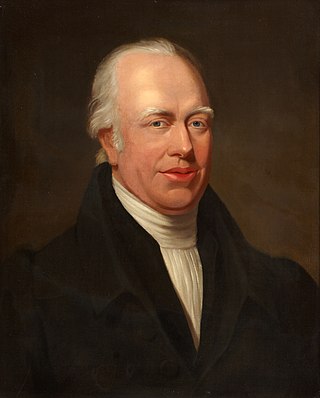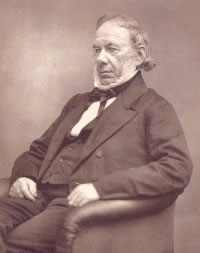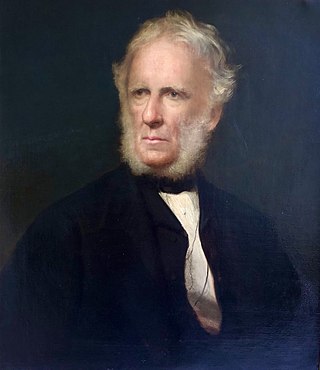
Calico is a heavy plain-woven textile made from unbleached, and often not fully processed, cotton. It may also contain unseparated husk parts. The fabric is far coarser than muslin, but less coarse and thick than canvas or denim. However, it is still very cheap owing to its unfinished and undyed appearance.

Longman, also known as Pearson Longman, is a publishing company founded in London, England, in 1724 and is owned by Pearson PLC.

The spinning jenny is a multi-spindle spinning frame, and was one of the key developments in the industrialisation of textile manufacturing during the early Industrial Revolution. It was invented in 1764-1765 by James Hargreaves in Stan hill, Oswaldtwistle, Lancashire in England.

Clayton-le-Moors is an industrial town in the borough of Hyndburn in the county of Lancashire, England. located two miles north of Accrington. The town has a population of 8,522 according to the 2011 census.

Oswaldtwistle is a town in the Hyndburn borough of Lancashire, England, 3 miles (5 km) southeast of Blackburn, contiguous with Accrington and Church. The town has a rich industrial heritage, being home to James Hargreaves, inventor of the spinning jenny and Sir Robert Peel of calico printing fame. The Leeds and Liverpool Canal passes through the town and was responsible for the export of much of the area's cotton produce.

Antimony trisulfide is found in nature as the crystalline mineral stibnite and the amorphous red mineral metastibnite. It is manufactured for use in safety matches, military ammunition, explosives and fireworks. It also is used in the production of ruby-colored glass and in plastics as a flame retardant. Historically the stibnite form was used as a grey pigment in paintings produced in the 16th century. In 1817, the dye and fabric chemist, John Mercer discovered the non-stoichiometric compound Antimony Orange, the first good orange pigment available for cotton fabric printing.

Adam Clarke was a British Methodist theologian who served three times as President of the Wesleyan Methodist Conference. A biblical scholar, he published an influential Bible commentary among other works. He was a Wesleyan.

Morris, Marshall, Faulkner & Co. (1861–1875) was a furnishings and decorative arts manufacturer and retailer founded by the artist and designer William Morris with friends from the Pre-Raphaelites. With its successor Morris & Co. (1875–1940) the firm's medieval-inspired aesthetic and respect for hand-craftsmanship and traditional textile arts had a profound influence on the decoration of churches and houses into the early 20th century.
Garnerville, previously known as Calicotown, is a hamlet in the town of Haverstraw, Rockland County, New York, United States, located north of New York City; east of Mount Ivy; south of Stony Point and west of West Haverstraw. Most of the hamlet is within the West Haverstraw village, while a small portion of Garnerville defaults to the town of Haverstraw.

Textile printing is the process of applying color to fabric in definite patterns or designs. In properly printed fabrics the colour is bonded with the fibre, so as to resist washing and friction. Textile printing is related to dyeing but in dyeing properly the whole fabric is uniformly covered with one colour, whereas in printing one or more colours are applied to it in certain parts only, and in sharply defined patterns.

The River Hyndburn is a minor river in Lancashire, England. Beginning as Woodnook Water on the slopes of Goodshaw Hill, it passes through Stone Fold, Rising Bridge and Baxenden where it is augmented by streams from Thirteen Stone Hill and continues to the Woodnook area of Accrington. Near St James Church, it collects Broad Oak Water, becoming the River Hyndburn. It heads northward through the town centre, collecting Pleck Brook and turning west, flowing under the East Lancashire railway line viaduct and continuing to Church.

James Watney was an English brewer and landowner who resided at Haling Park, Croydon, and Beddington, Surrey. He was born to Daniel Watney (1771–1831) of Mitcham, Surrey and Mary Galpin (1771–1830), daughter of James Galpin of Mitcham, Surrey. He was the grandson of John Watney (1747–1814) and great-grandson of Daniel Watney (1705–1780) of Wimbledon, Surrey who was an ale conner.

Merton Abbey Mills is a former textile factory in the parish of Merton in London, England near the site of the medieval Merton Priory, now the home of a variety of businesses, mostly retailers.

Hyndburn Brook is a minor river in eastern Lancashire. It is approximately 4.5 miles (7.3 km) long, and has the catchment area of 13.61 square miles (35.243 km2).

John Mercer was an English dye and fabric chemist and fabric printer born in Great Harwood, Lancashire. In 1844 he developed a process for treating cotton, mercerisation, that improves many of its qualities for use in fabrics.

William Kilburn (1745–1818) was an illustrator for William Curtis' Flora Londinensis, as well as a leading designer and printer of calico. A few hundred originals of his water colour designs make up the Kilburn Album, housed at the Victoria and Albert Museum in London.

Edmund Potter (1802–1883) was a Manchester industrialist and MP and grandfather to Beatrix Potter.

Sir Cyril Ernest Harrison was a cotton industrialist. He was President of the Federation of British Industry and Confederation of British Industry during the 1950s and 1960s following his work as Managing Director at English Calico.
James Thomson was an English industrial chemist who made a career and large reputation in calico printing. He became a Fellow of the Royal Society in 1821.
Samuel Holroyd "Tim" Burton was a British school teacher, college lecturer and prolific author of English language textbooks and books about the west of England. He also produced fiction, assembled anthologies and wrote a biography of William Shakespeare.



















